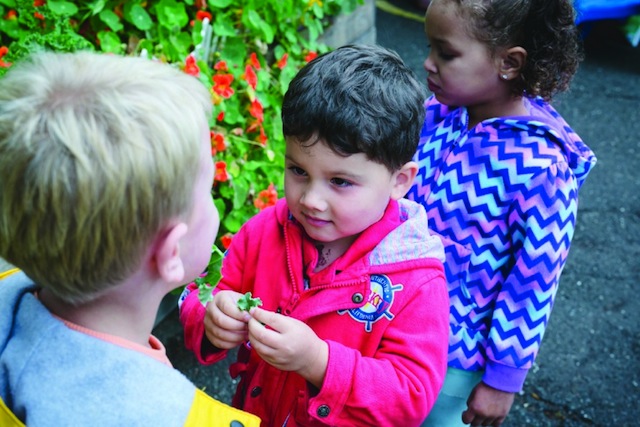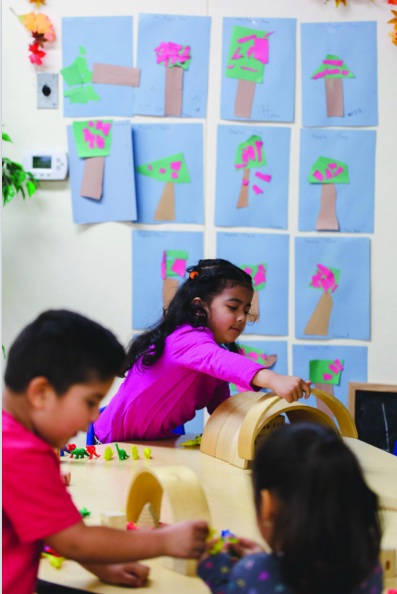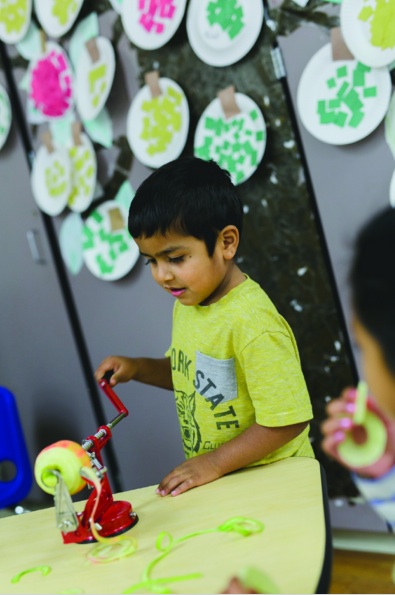Farm to Preschool benefits kids and farmers.
In early September of this year, the students at Gold Ridge Preschool in Rohnert Park studied apples with their teacher, Andrea Pfeifer. They began at the beginning. Where do apples come from?
“Some of the kids thought that apples come from the store,” says Pfeifer, the site supervisor at Gold Ridge. Then she showed them a photo of an apple farmer at the family-owned Devoto Orchards in Sebastopol.
“It’s not from a grocery store,” one of the kids declared. “It’s from a grandpa. He grew them!”
Classroom moments like this are powering a growing national movement to connect preschools with producers of healthy and nutritional food. In the long term, farm to preschool advocates hope to achieve two goals: a reduction in childhood obesity and an increase in market opportunities for local farmers and producers.
In Sonoma County, a four-pronged partnership aimed at expanding farm to school efforts at low-income nonprofit preschools launched in early 2016 with the help of funding from a competitive USDA grant that runs through June 2017. The money, which is administered by the Sonoma County Department of Health Services, enabled an increase in programs, parent education, and fresh produce at 15 Community Child Care Council (4Cs) and the North Bay Children’s Center (NBCC) preschool programs. The 4Cs and NBCC offer free morning and afternoon preschool programs for low-income kids between the ages of 3 and 5.
“[Farm to preschool] is part of developing a culture of health and creating a food system that works for everyone,” says Angie Corwin-Laskey, North Coast regional manager for the Community Alliance with Family Farmers (CAFF), the fourth partner in county farm to preschool efforts. “We’re putting money into the pockets of farmers; we’re educating the students and families on where their food comes from; we’re showing the preschool sites and the organizations that this can happen, that it doesn’t have to be so challenging that it’s preventative.”
A California-wide nonprofit, CAFF’s mission is to build sustainable food and farming systems through policy advocacy and on-the-ground programs that create more resilient family farms, communities, and ecosystems.
Thanks to the USDA grant, CAFF was able to expand its popular Harvest of the Month program to the 15 4Cs and NBCC preschool sites. Already in place in hundreds of elementary classrooms across Sonoma County, the program is now able to reach more preschoolers at an age when exposure to healthy food is crucial to future eating habits. CAFF is also hard at work figuring out how to streamline logistics, infrastructure, data collection, and connections between local farmers and preschools so that teachers like Andrea Pfeifer can focus on what they do best—working with children.
Farm to preschool is part of an upstream approach, says Brian Vaughn, director of the Division of Health Policy, Planning, and Evaluation at the Sonoma County Dept. of Health. According to data from the California Dept. of Education, 37 percent of students in 5th, 7th, and 9th grades in Sonoma County are overweight or obese.
“It’s vitally important that kids are eating healthy foods from the start; that sets them up for lifelong eating habits,” says Vaughn. “And that’s why we are investing in even younger kids. All the data is there to say if you can expose them to a variety of healthy foods when they’re young, they’re just so much more likely to continue that into adulthood. Farm to preschool is pretty new for us. We’re expanding some of the successes we’ve had in the elementary system even more upstream.”
Back at Gold Ridge Preschool, Pfeifer shows me the Harvest of the Month tasting kit for September. Outside, the morning class romps and plays outside under the supervision of the other teachers. Pfeifer places a bag of glossy orange and red bell peppers from a local farm on the table before us. The tasting kits are processed through F.E.E.D Sonoma, a micro-regional food distribution hub out of Sebastopol, which works in partnership with CAFF to collect produce from the farmers, pay them a fair price, and get the boxes delivered to school sites. Every school receives enough of the month’s vegetable or fruit to cut up and give out as tasting samples to the children. The box also contains lesson plans, a profile of the farmer, identification sheets, and a nutrition newsletter with recipes and such in both Spanish and English for parents.
A longtime practitioner of edible and environmental early childhood education, Pfeifer also places importance on educating parents outside of the classroom through monthly parent nights. At a future event, parents will learn the ins and outs of farm to preschool.
CAFF has also partnered with three of the preschool sites—Gold Ridge is one—to analyze where schools are buying their food, and how to increase purchases from local farmers. While all of the preschool sites serve fresh produce as part of their food programs, it’s not necessarily sourced locally. CAFF would like to see that change.
“We were chosen to be part of the Farm to Preschool partnership because of our partnerships with farmers, and our focus on working with farmers that are already committed to growing sustainably,” says Corwin-Laskey. “It’s just the perfect match.”
Challenges remain, even with the logistical and infrastructure support from FEED Sonoma—mainly with pricing, since preschools don’t buy enough food to qualify for wholesale prices. Corwin-Laskey would love to find grocery store owners that might be interested in partnering with preschools to help provide local produce. Another possibility is partnering with local farmers that farm near the school sites. “Perhaps they could plant an extra row for the school,” she says. “And we would pay them for the food.”
After nearly a decade as a 4Cs teacher and site supervisor, for her part, Andrea Pfeifer has seen firsthand the innumerable benefits of teaching her students (and parents) about healthy, whole foods and nutrition. She’s paid back in a classroom of youngsters that are engaged, energetic, and excited about healthy food. That’s one upstream investment that’ll go a long way.
Article resources:
caff.org/programs/fts/farm-to-school




